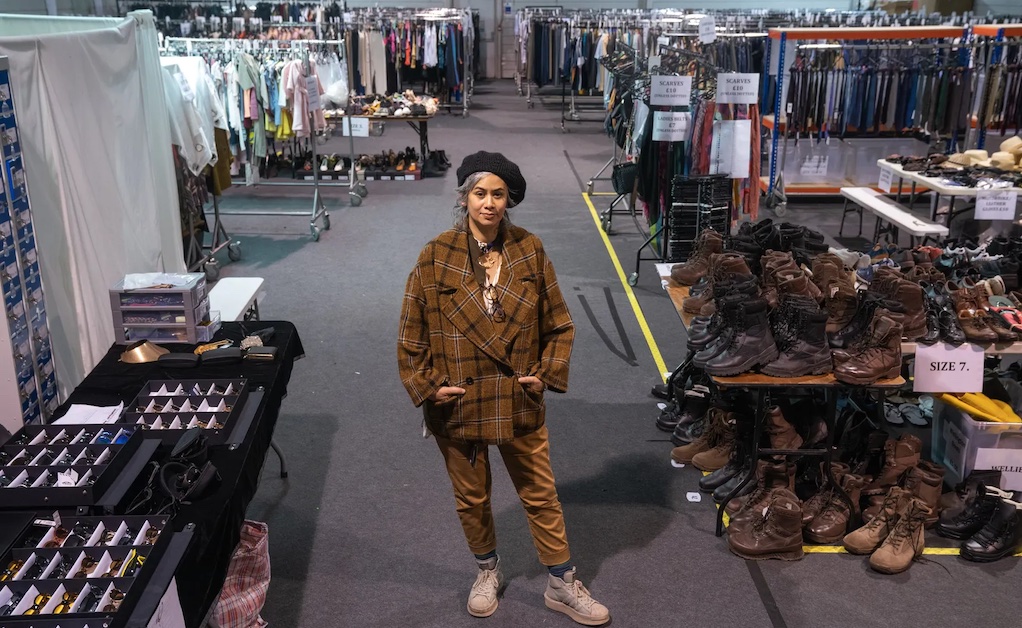
Every character in a Star Wars story could be a main character. At least, that’s what you want from stories set in the George Lucas-created universe, where the mere presence of extras can tell a tale or ignite the audience’s imagination. Costume designer Suttirat Anne Larlarb not only narrates the story of Obi-Wan Kenobi (Ewan McGregor) but also brings to life nearly every facet of human and alien existence in director Deborah Chow‘s miniseries.
For her intricate work on Obi-Wan Kenobi, Larlarb earned a nomination for Outstanding Fantasy/Sci-Fi Costumes at the 2023 Emmys. This isn’t her first nomination. Previously, she received a nomination for HBO’s Cinema Verite and won an Emmy for her Art Direction during the London 2012 Olympic Games Opening Ceremony, where she once again collaborated with filmmaker Danny Boyle.
Larlarb, who also worked on No Time to Die, dreams big. Recently, in a conversation about Obi-Wan Kenobi, the costume designer shared that she actually does dream about costume designing. She also delved into her remarkable team’s contributions and why maintaining a sense of curiosity is crucial.
BTL: What part of the world are you in at the moment?
Larlarb: I’m in Bangkok, Thailand, at the moment.
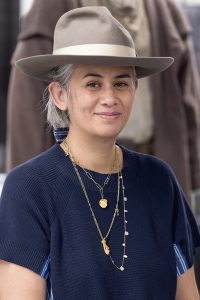
BTL: How is it being a costume designer in Bangkok? What are you finding inspiring?
Larlarb: Well, I have Thai heritage, so I’m pretty familiar with Bangkok, just from my personal family history. I’ve not worked here in the capacity as a designer in the many, many years I’ve been coming here to visit family. What’s really nice is that working on any show or a film or project has been, in my life, all-consuming that I often sacrifice things like seeing family, going to weddings. I’m the worst aunt, I miss people’s birthdays, and here on my one day off a week, I get to do all of that, which is nice because I’ve not really been able to over the years. I’m having, let’s say, a little bit more injection of life outside the world of filmed entertainment, yes.
BTL: Very important for a costume designer, right?
Larlarb: Yeah, actually, yes.
BTL: Even on something like Obi-Wan where you’re in a sci-fi universe, what are some of the personal experiences, places you’ve traveled to that inspired some of your creative choices?
Larlarb: I actually think one of the things that Deb Chow and I talked about is the importance of culture in the Star Wars universe. Each world you go to, it’s not an invented world for the sake of invention’s sake or changing attributes of an environment or a planet or character’s behavior, just to have something new and different from some other thing you did. Every planet, every culture that exists within Star Wars is so rooted in what the environment of that culture is, what the politics of that culture is, and what is the industry of that planet? What are their natural resources? How do the people interact in their class system within?
As someone who’s traveled all my life, I really feel that my observation of the world outside of just work world or even growing up in the States had been really valuable to approaching a project for this franchise, because we had a few new worlds we were visiting in Obi-Wan Kenobi. Knowing how to, I guess, dive in on a very elemental level first, that starts to open up decisions that you make about colors, about kinds of materials available, about how people might be, what their work wear looks like because of the environmental conditions, the temperature, the dryness of Tatooine, the humidity of another planet. It’s all interconnected. And so, it’s a great question, because our approach from the very get-go was rooted in cultural studies.
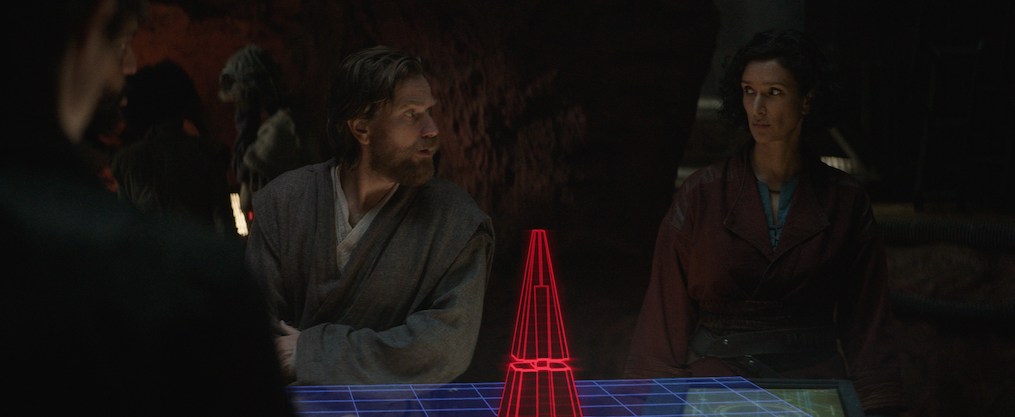
BTL: In the last few years, you worked on Obi-Wan and No Time to Die, both franchises with a long history. How do you try to balance paying respect to the past but also bringing in new ingredients?
Larlarb: Well, I guess on something like the Bond film, you have to, and Star Wars, because it’s such an iconic franchise, there’s definitely history that needs to be respected. There’s a fanbase that is so knowledgeable, so you want to do your homework, and you want to be able to make sure that you’re hitting all the notes, and in some ways, giving the respect to the fans while you’re doing the work to what their knowledge and understanding of the worlds are going to be. There’s that responsibility and that weight that you carry when you enter upon something like this.
Specifically to Obi-Wan, there was another level of responsibility, which is, it wasn’t just that it was stuff that came before, and then here’s this new chapter, go forward and do whatever, take whatever you want from the past, apply it to the future. With Obi-Wan, we had a future already. We knew where the story was going. We’re actually slotting into a specific timeline. So it wasn’t that we were just needing to pay attention to what came before it, I also needed to pay attention to what was going to be unfolding in the future of a bunch of these characters’ stories from A Hew Hope being the next chapter, essentially.
Having said that, our responsibility, when you take on something new like this, is also to push things forward. You don’t want it to just be a documentarian version of what came before, where you’re not opening things up to make things juicy and exciting and surprising. You still need all those things to have any great drama. Any great entertainment needs something new.
What’s nice about having those, for lack of a better word right now, rules of what came before and what comes after, is it at least it gives you a little bit of a structure for your blue sky thinking. You don’t want to go so far that it doesn’t make sense for what unfolds in the next chapter to happen.
In some ways, it makes it more challenging and you have to be more creative. Obviously, Deborah was such a repository of what came before, what comes next, and also what she wanted to do during the series. Very early on, in part due to the conversations we had about how to approach things, like from a cultural standpoint or an anthropological standpoint, if that’s the right word, considering we’re not only talking about human characters…
Actually, to go back to your first question about what specific cultures, I will say something that struck me from my own personal background. Not to say that I lifted some idea from something Thai, but here in Thailand, the former queen was very, very involved in reinvigorating the textile industry here in this country. There’s a lot of textile crafts and practices here that are, sorry for the pun, interwoven into a lot of visual culture here.
That interconnectedness of her motivation to bring forth traditional crafts into her modern wardrobe when she was the queen and when she’s the queen mother now, that is actually something that I had thought about when I was thinking about Young Princess Leia’s family and Alderaan, and how the queen might have taken cues from the environment around her and the traditional crafts and the motifs, the floral motifs.
It was actually a really nice window into creating something very special and specific to that planet that spoke to an aspect of character that Deb was really wanting me to focus on, which is the influence of the mother on the daughter, even though Leah’s adopted into that family, but how do we show that they’re connected to their land, their planet? I took that thing that I remember just from my own understanding of my culture here, and that in a small way, I didn’t lift anything from Thailand, but just that idea that you can interweave things so that nothing is a random choice, that everything’s connected.
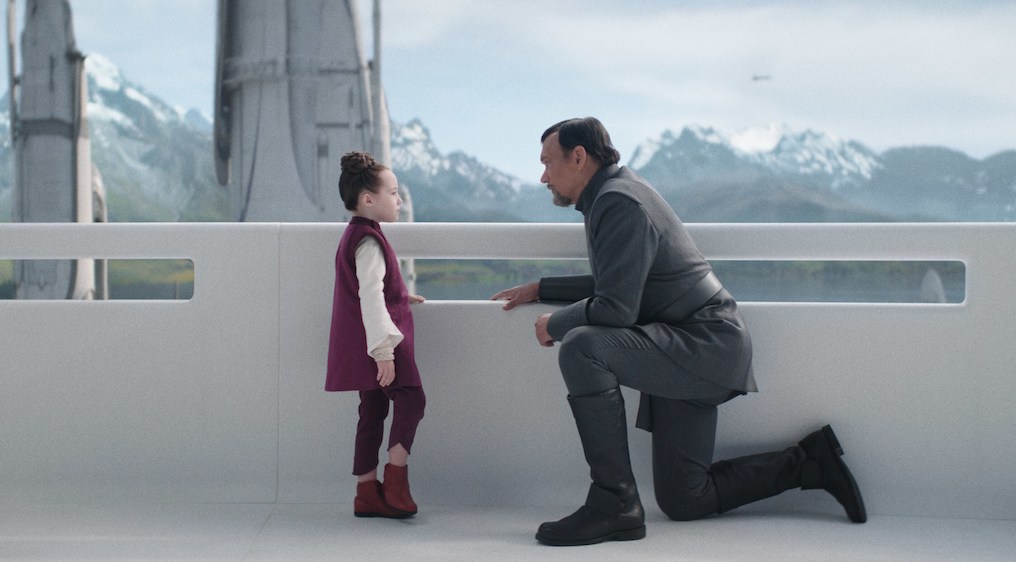
BTL: You worked on the show three years ago. Now, in a broad creative sense, how do you reflect on the show and the work you did?
Larlarb: It was such a gift. When I’m working, I don’t take the time when I’m working to sit back and remind myself how cool it is to be doing what I’m doing. It happens a little bit later, and that’s not because I’m not grateful for the chance or I’m not respecting the weight of the responsibility. It’s because the work is so intense and there’s so much to do that I want to make sure that all my attention is on the work and what needs to happen.
And so, you have to be as ready for all of that, and the resources available are incredible. I had access to the archives, which was one of the moments where I thought to myself, “Oh my God, I’m doing Obi-Wan Kenobi.” I got to go to the Lucasfilm archives and touch and see all the original things from the ’70s films and the prequels, and all of it in a very well organized storage place. It was just so well-preserved. It was entering something magical for me, and I was able to let myself go a little bit and feel like a kid.
Another couple of moments, I remember the day, the first time we had Jawas on set, which is not a costume I designed. There are rules about Jawas, and we had our own specific characters within Obi-Wan, but obviously, we’re abiding by what came before and still making them individual. But I remember the first time they arrived on set, anybody who passed by where we were getting them ready just stopped what they were doing to be like, “Oh my God, I have to go up close and look.” There were a lot of going back to feeling like a kid moments during the shoot. And then you snap out of it and you’re like, “Oh my God. That’s exactly why I have to get back to work and be 100% serious about this.”
BTL: A lot of artists try to maintain that childlike curiosity or wonder, but obviously, it’s tough with the schedules and all the pressure. For you, how important is that as a costume designer and a storyteller, maintaining that childlike excitement?
Larlarb: It’s really important. I think it’s fundamental. You can get so caught up in the lists of to-dos, like deadlines, and you should. It’s all deadline driven, it’s all schedule driven, and it’s all actor availability driven. There’s a lot of columns that have to be ticked in order to for every department’s elements to be on set on the day to come together and synthesize into the magic that you end up seeing on screen for one second or one minute of a project.
But I think it’s so important to constantly be curious and to constantly turn stones, to keep trying to make things better, to keep looking. I found myself even with design decisions that I had made early on in the process, where we’d already gone through a fitting process, or say concepting, sketching, prototypes, fitting and presentation, where all of that was already all ticked off, and all that needed to happen was it needed to be established on camera.
I have this thing where, before it gets established on camera, I’m looking so intensely at the work. I’m looking at the costume on the character in the environment, with the other costumes on their characters in the environment, or even dialogue between them, and I’m thinking, “Have I hit everything that makes this scene make sense? What can I do with the costume, or what can I suggest, or what can I ask myself or the director about another option at the last minute that can come in and just lift that into the exact right tone you need right in that moment?”
I remember years ago working with a lovely director who — I can’t even remember what project, and I was not the designer but in the ranks of the department — whenever he would call action, I could see, behind the monitor, he held his breath and I thought, “Is he ever going to exhale?” And then the scene would be over and you’d get this loud exhale.
As a younger person with not that much experience at that time, I wondered what that was about. Now that I’m in middle age and have done it 25-ish years, and at the level that I’ve been privileged to operate within, I totally understand that. I understand that there’s so many moving parts and so many decisions that you spent months tooling over, and options you’ve tried, and all the backup plans, and all the trial and error, and then all the victories coalescing in a moment.
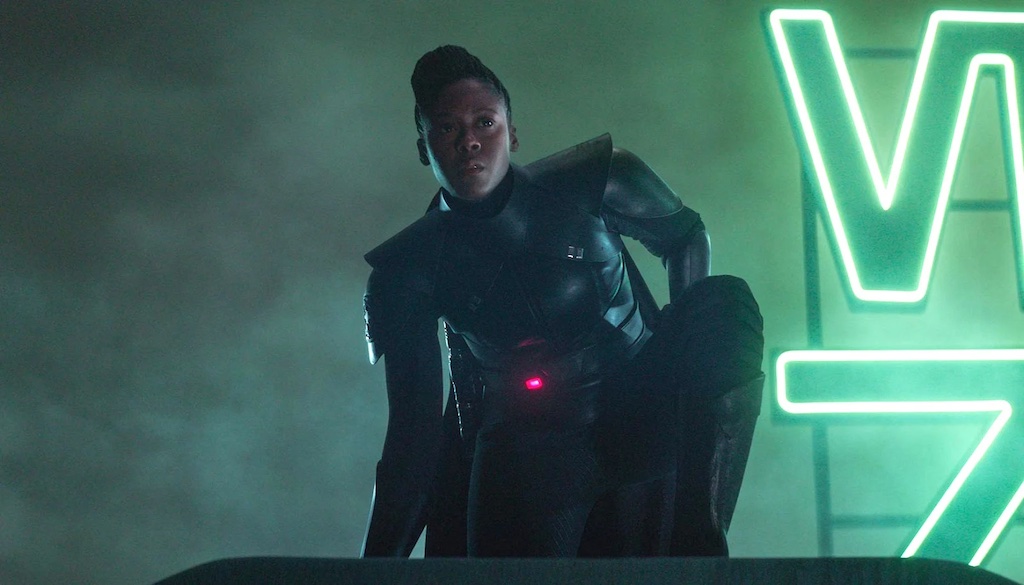
BTL: You work on these huge canvases as a costume designer. Throughout your career, I imagine there were expectations as to what that’d be like, having all these resources. How does the reality compare to the expectations when you’re, let’s say, invited into the big parties?
Larlarb: I’m driven by, maybe not that in the way you described it, but more by, let’s say, once I’m invited to the party, get a job opportunity like Star Wars or the Bond film or anything of that level, I am excited for the time that I get the official thumbs up. Yes, you’re doing it. It’s all good. It’s all happening. And then I start to scare myself into, all right, now you’ve got to hunker down and get serious about this and do everything you can.
I squeeze every creative molecule out of me that I can, and it comes with me when I sleep. I have dreams about fabric swatches or even imagined dialogue where it’s not even on the script page, but it might have come from a conversation I had with a director or an actor, and it invades my dreams, and the next morning it influenced some other decision I have to make.
It gets very internalized in me, and I don’t really turn off on the weekends or in the evenings. It’s always there. So, it can be very all-consuming. Part of it is probably due to the weight of exactly what you’re saying: working at the level that maybe you didn’t imagine. I love obviously helping build characters, and I definitely would not necessarily have imagined that I would’ve gotten to do the things that I’ve now done, but because maybe I didn’t imagine them, when I got those opportunities, I made sure that I didn’t regret any moment of my commitment to it.
The fact that the Emmy nomination comes a couple of years later, I reached out to some of my colleagues. I still need to reach out to a bunch to say thank you, because it really is… You get this recognition, as did my assistant costume designer, Stacia [Lang], as did my supervisor, Lynda Foote. Our names are there, but there’s this entire ecosystem. There’s Lynda, Stacia, [assistant costume designer] Cindy [Rosenthal], and [fabric/costume buyer] Elise [Drozdowski]… They listen to what your wishes are, they look at your drawings, they hear you talk about character. They’re in the fittings with you, and then they go off and they do all their magic and they bring you the options.
We had a two-story building that we were working in. We were one of the first productions to operate during lockdown. We had no vaccines yet, so it was in the initial part of the lockdown. We were all navigating new ways of working, and there’s a lot of togetherness that has to happen, but we weren’t really allowed to operate like that because of not knowing.
So all our desks were so far apart. We were all masked up. I didn’t know what a lot of my team looked like for a good five months until we were able to take our masks off and sit together, far apart at a lunch table outside together. The camaraderie that you need to produce something of this magnitude, we still had, because I’ll credit the fact that it was Star Wars, where everybody was so excited to work on it. That was the maybe je ne sais quoi that allowed us to all come together at a time where otherwise it would’ve been really difficult, because you don’t get to really see each other up close and touch fabrics together.
You’d get a fabric put on your desk, and then that person would back away, and then I’d pick it up, and then I’d have to walk 20 feet to go give them a note about something. There were a lot of strange new practices. Usually, it’s a big huddle and a bullpen.
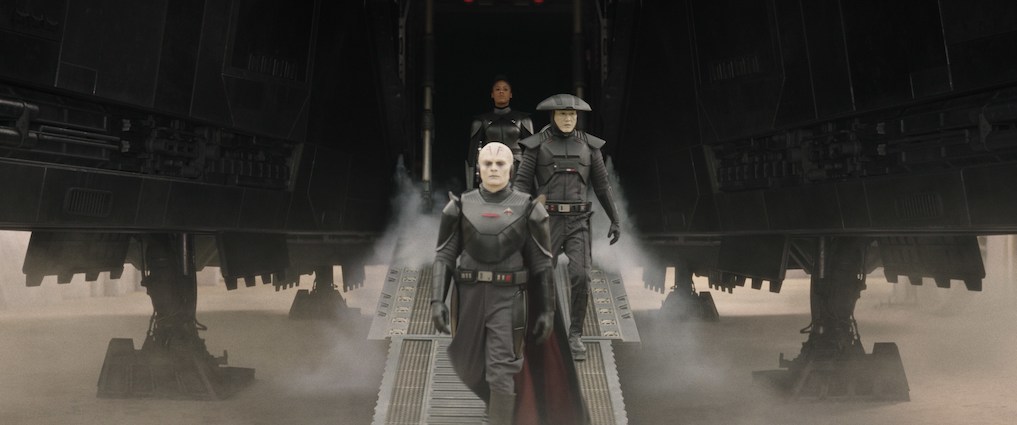
BTL: Did going through that experience change you as a costume designer?
Larlarb: Yeah, it absolutely did. It reminded me of how important the team is. So much of COVID in general, and that initial part of the lockdown and how we were going to work, was about reminding ourselves to stay apart from each other for reasons, and realizing that so much of our work required us not to be apart. How the team worked, and they worked extra hard, and there was just the stress that whatever everybody’s [got] going in their own lives was left outside, and we just all came together to do this project.
I grew up in LA, but I very rarely worked there, and that was one of the first things I had ever worked on in LA. A lot of people knew each other, and it was an incredible team. We actually did a calculation of how many people we had at any one time, and it’s an enormous number, and that’s before we got to shooting. It’s over 50 people in the workshops doing various things, and we have our craft people, we have the tailoring and sewing and stitching team, the cutters, the drapers.
In the design area, there’s just a handful of people, the buyers, and then all the logistics people, and then the background. Lee Bell, who was in charge of the background, so much of Star Wars is the background and the worlds that the lead characters will walk into. You have to believe right away you’re in Tatooine or Alderaan or Mapuzo or wherever you were in.
As we worked, I was upstairs and they were downstairs, and every time there was a new body of individuals being fit according to research or sketches or prototypes we had made and then sent down for the background fittings, it was watching those worlds emerge. And then seeing everybody on set all together instead of just against the fitting background, it really does take a — I love this word — ecosystem, because everybody has to work together. It’s not just a village, because in a village, maybe people don’t have to work together, but it’s an ecosystem.
BTL: I like that. They should just say ecosystem, not auteur, from now on.
Larlarb: Yeah. I’m so happy that there’s been recognition for our work, but I also wish there was a way that everybody could be on the nomination certificates or on whatever goes out, because truly, I can’t think of one person whose contribution wasn’t integral in some way. Truly integral, not just passive. There were no warm bodies. Everybody just brought their A-game.
The Emmy-nominated Obi-Wan Kenobi is available to stream on Disney+.





